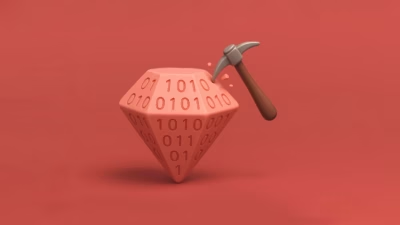Today, while cleaning out an old Dropbox folder, I stumbled upon my very first data science project. Oh boy. It was a Frankenstein’s monster of random datasets, misused formulas, and charts that could make a grown analyst cry. If I could send a time-traveling Slack message to my beginner self, it would scream: “Learn your stats basics before you touch that model!”
So if you’re just starting your data science journey (or you secretly feel like you should’ve done a stats refresher a long time ago), you’re in the right place. Let’s walk through the real must-know statistics concepts — not the ones that make you memorize definitions, but the ones that make everything else in data science finally click.
1. Mean, Median, and Mode: Your First Data BFFs
Alright, let’s talk about averages — the deceptively simple gang of three: mean, median, and mode.
Early on, I was analyzing a dataset on salaries. Everything looked good… until I noticed the average salary was over $400k. Turns out, one tech founder with stock options the size of a small country was skewing the whole thing. That’s when I learned the hard truth: the mean is easily manipulated.
The median, on the other hand, just shrugs off outliers like they’re not even there. It’s the middle value — totally unbothered by extremes. For most real-world messy data (income, house prices, anything with wild tails), it’s the better storyteller.
And the mode? Honestly, it doesn’t come up often in predictive modeling, but it’s weirdly useful when you’re working with categorical data. Think most common zip codes for shipping, or most frequently purchased product.
👉 Quick tip:
If your data looks suspiciously off — like it partied too hard — run all three. Then decide who you trust.
2. Variance and Standard Deviation: Feeling the Spread
Let’s say two companies both report average delivery times of 2 days. Sounds identical, right? But when you look closer, Company A delivers everything between 1.8 and 2.2 days. Company B swings wildly between 1 and 4. Same average, totally different customer experiences.
That’s variance and standard deviation doing their quiet but crucial work.
Variance tells you how far your data spreads out from the mean — like how much your kid’s Lego bricks are scattered across the living room. Standard deviation is the same, just in the original units of the data, making it easier to interpret.
I used to gloss over these metrics when building models. Huge mistake. Variability can make or break your interpretation of a dataset. And later on, when you’re tuning models or measuring uncertainty, you’ll lean on these stats like your favorite hoodie.
👉 Quick tip:
High standard deviation? Your data’s chaotic. Low? It’s well-behaved. Either way, now you know what you’re working with.
3. Probability: Predicting the Unpredictable
Probability is where things start to feel like Vegas — except the stakes are model accuracy and your credibility instead of blackjack chips.
It’s the foundation of predictive analytics, Bayesian inference, classification models — basically, anything that involves guessing outcomes.
I once had a manager who insisted a 5% error rate was “negligible.” On paper, maybe. But if you’re flying a plane or diagnosing cancer, 5% is massive. That moment sent me back to probability 101 — which, by the way, should be required reading before you ever touch a confusion matrix.
Probability isn’t just math. It’s the language of uncertainty. Learn to speak it fluently, and you’ll see the world differently.
👉 Quick tip:
Try explaining Bayes’ Theorem to your mom using weather forecasts. If she gets it, you’ve nailed it.
4. Distributions: Shapes Tell Stories
Ever stared at a histogram and felt like it was trying to tell you something? Good. Because it is.
Distributions show how values are spread across your data. A normal (bell-shaped) distribution? Great. That means most values cluster near the mean — like adult heights or test scores. Easy to model. Easy to interpret.
But sometimes your data leans way left or right — skewed distributions. That’s when you get weird results, like income data where a handful of mega-earners distort the average.
And then there are bimodal distributions, which often mean you’re actually looking at two groups mashed into one dataset. I once saw this when analyzing user session times — turns out we had both power users and casual browsers lumped together.
👉 Quick tip:
Always visualize your data. A histogram will reveal secrets the summary stats try to hide.
5. Central Limit Theorem: Your Secret Weapon
This one’s the unsung hero of statistics. It sounds like something you’d hear in a sci-fi movie, but the Central Limit Theorem (CLT) is beautifully practical.
It says: take enough random samples from any population — no matter how messy or skewed — and the distribution of their means will look like a bell curve. That’s why we can use normal distribution techniques even when the raw data isn’t normal.
When this clicked for me, everything from A/B testing to margin of error made way more sense. Like, ohh that’s why the z-table is obsessed with the number 1.96.
👉 Quick tip:
As long as your sample size is large (say 30+), CLT’s got your back — even if your data looks like chaos.
6. Hypothesis Testing: Decisions with Confidence
If statistics were a crime show, hypothesis testing would be the courtroom drama scene.
You start with a null hypothesis — the status quo, like “This ad doesn’t affect conversion.” Your job? Find enough statistical evidence to convict it. If the p-value (aka how surprised we should be by the result) is small enough, we reject the null.
But here’s the kicker: low p-value ≠ guaranteed truth. It just means the data is unlikely if the null were true.
I used to think p < 0.05 meant instant success. But p-hacking is real, and overconfidence kills credibility.
👉 Quick tip:
Don’t worship p-values. Use them in context, with thoughtful experiments and sanity checks.
7. Confidence Intervals: Beyond One-Number Thinking
Early on, I got into the habit of reporting single values like I was reading off commandments. “The average load time is 2.1 seconds.” Boom. Mic drop.
Then I learned about confidence intervals. They don’t just say “here’s the average.” They say, “we’re 95% confident the real value falls between 1.9 and 2.3 seconds.” That’s not just better — it’s more honest.
Confidence intervals are basically the “margin of error” you see in political polling. They reflect how certain we are about our estimate based on the data we have.
👉 Quick tip:
Whenever you can, give a range. It signals humility — and better understanding.
8. Correlation vs. Causation: The Eternal Trap
Ah yes, the classic mistake. I’ve made it. You’ve made it. Entire startups have made it.
I once worked with a team that noticed higher email engagement correlated with more customer churn. They nearly killed the email campaign. But the real issue? Support emails were sent more often after customers complained — a classic case of reverse causation.
Correlation means two variables move together. Causation means one actually affects the other. They’re not the same — and confusing them leads to wild conclusions and embarrassing strategy meetings.
👉 Quick tip:
Always ask: Could something else be causing both variables to move together?
9. Sampling Methods: How You Pick Matters
Here’s the thing about data: if your sample is flawed, the whole analysis crumbles — no matter how fancy your model is.
Random sampling is the gold standard — everyone has an equal chance of being picked. But sometimes that’s not practical, so we get clever: stratified sampling (divide into groups, then sample) or cluster sampling (sample whole groups).
I once made the mistake of analyzing customer sentiment using feedback only from our premium users. Naturally, the results were glowing — but totally unrepresentative of our average customer.
👉 Quick tip:
Before you analyze, audit your sample. Garbage in, garbage out.
10. Overfitting and Underfitting: When Models Go Wild
You know that friend who tries way too hard to fit in at every party? That’s overfitting. Your model memorizes every little quirk in the training data — even the random noise. It performs great on the data it’s seen… and flops in the real world.
Underfitting, on the other hand, is like a lazy intern who didn’t read the assignment. The model is too simple and misses key patterns entirely.
The fix? Balance. Understand your data. Use cross-validation. And remember: sometimes the simplest model — a humble linear regression — is all you need.
👉 Quick tip:
Complexity isn’t always clever. Start simple. Earn fancy.
Wrapping Up: Your “Trusty Stats Compass”
I’ll be honest: stats scared me for years. It felt like some elite club where everyone was better at math and had shinier calculators. But once I started thinking of stats not as formulas but as tools for making smarter guesses, the fog lifted.
You don’t have to memorize every formula. You do have to understand what the numbers are trying to tell you.
tl;dr:
- Stats isn’t about being perfect. It’s about being less wrong.
- Plot everything.
- Think in ranges.
- Always, always question your assumptions.
And if you tattoo one thing from this guide into your brain (no pressure), let it be this:
👉 Better questions > fancier answers.
Quick reality check before end: everything we’ve walked through here is designed to make the concepts click — to give you that “ohhh, now I get it” moment. But real-world data is messy, and context always matters. The exact conditions, distributions, or assumptions might shift depending on your dataset, industry, or goal. So treat these as your starting compass, not hard-and-fast rules carved into granite.





